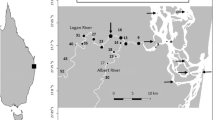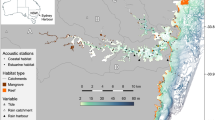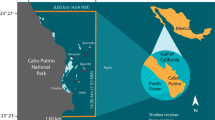Abstract
Large estuaries are often highly productive and biodiverse areas of ecological and economical significance. Assessing the movement behavior and space use patterns of mobile organisms in these highly dynamic areas is critical for understanding ecological dynamics within systems. Fine-scale movement data, which is useful for successful species management and conservation, is lacking for ecologically relevant species in many estuarine systems, due to the demands for fine-scale data collection methods and increased use of more passive tracking methods. Six bonnetheads (Sphyrna tiburo) and four bull sharks (Carcharhinus leucas) were tracked within the Apalachicola Bay system using active acoustic telemetry for periods up to 52 h to compare space use patterns and rates of movement across tidal and diel cycles. Tidal and diel periods had significant effects on the rate of movement (ROM) of both species, with increased ROM during crepuscular periods. Movement behavior was likely driven by a combination of optimal foraging strategies, predator avoidance, and abiotic factors. Unique movement behaviors exhibited by mature bonnetheads provide clarity for their high bycatch rates in the Gulf of Mexico shrimp trawl and should be considered during the formulation of conservation and management measures for the species. By comparing simultaneous active and passive acoustic telemetry data from bonnetheads, we determined that ROM has a negative effect on passive acoustic detection success. More investigation into the effects of environmental conditions and movement on detection efficiency is needed as passive telemetry becomes more widely used to study aquatic animal movement.





Similar content being viewed by others
Code availability
Code written for data analysis for this study will be made available from the author by request.
References
Ackerman JT, Kondratieff MC, Matern SA, Cech JJ (2000) Tidal influence on spatial dynamics of leopard sharks, Triakis semifasciata, in Tomales Bay, California. Environ Biol Fishes 58(1):33–43. https://doi.org/10.1023/A:1007657019696
Bethea DM, Hale L, Carlson JK, Cortés E, Manire CA, Gelsleichter J (2007) Geographic and ontogenetic variation in the diet and daily ration of the bonnethead shark, Sphyrna tiburo, from the eastern Gulf of Mexico. Mar Biol 152(5):1009–1020. https://doi.org/10.1007/s00227-007-0728-7
Bethea DM, Ajemian MJ, Carlson JK, Hoffmayer ER, Imhoff JL, Grubbs RD, Peterson CT, Burgess GH (2014) Distribution and community structure of coastal sharks in the northeastern Gulf of Mexico. Environ Biol Fishes 98(5):1233–1254. https://doi.org/10.1007/s10641-014-0355-3
Calenge C (2006) The package adehabitat for the R software: tool for the analysis of space and habitat use by animals. Ecol Model 197:1035
Carlson JK (2007) Modeling the role of sharks in the trophic dynamics of Apalachicola Bay, Florida. American Fisheries Society Symposium 50:281
Carlson JK, Hale LF, Morgan A, Burgess G (2012) Relative abundance and size of coastal sharks derived from commercial shark longline catch and effort data. J Fish Biol 80(5):1749–1764. https://doi.org/10.1111/j.1095-8649.2011.03193.x
Chapman DD, Feldheim KA, Papastamatiou YP, Hueter RE (2015) There and back again: a review of residency and return migrations in sharks, with implications for population structure and management. Ann Rev Mar Sci 7:547–570. https://doi.org/10.1146/annurev-marine-010814-015730
Corn ML, Alexander K, Buck EH (2008) Apalachicola-Chattahoochee-Flint drought: species and ecosystem management (p. 25). Congressional Research Service
Cortes E, Manire CA, Hueter RE (1996) Diet, feeding habits, and diel feeding chronology of the bonnethead shark. Bull Mar Sci 58(2):353–367. https://doi.org/10.1007/s00227-006-0325-1
Curtis TH, Adams DH, Burgess GH (2011) Seasonal distribution and habitat associations of bull sharks in the Indian River Lagoon, Florida: a 30-year synthesis. Trans Am Fish Soc 140(5):1213–1226. https://doi.org/10.1080/00028487.2011.618352
Curtis TH, Parkyn DC, Burgess GH (2013) Use of human-altered habitats by bull sharks in a Florida nursery area. Mar Coast Fish 5(1):28–38. https://doi.org/10.1080/19425120.2012.756438
Dadswell MJ, Wehrell SA, Spares AD, Mclean MF, Beardsall JW, Logan-Chesney LM, Nau GS, Ceapa C, Redden AM, Stokesbury MJW (2016) The annual marine feeding aggregation of Atlantic sturgeon Acipenser oxyrinchus in the inner Bay of Fundy: population characteristics and movement. J Fish Biol 89(4):2107–2132. https://doi.org/10.1111/jfb.13120
DeGroot BC, Roskar G, Brewster L, Ajemian MJ (2020) Fine-scale movement and habitat use of whitespotted eagle rays Aetobatus narinari in the Indian River Lagoon, Florida, USA. Endanger Species Res 42:109–124. https://doi.org/10.3354/ESR01047
Doyle TK, Bennison A, Jessopp M, Haberlin D, Harman LA (2015) A dawn peak in the occurrence of “knifing behaviour” in blue sharks. Anim Biotelemetry 3(1):1–6. https://doi.org/10.1186/s40317-015-0084-1
Engen S, Stenseth NC (1989) Age-specific optimal diets and optimal foraging tactics: a life-historic approach. Theor Popl Biol 36(3):281–295. https://doi.org/10.1016/0040-5809(89)90035-x
Froeschke JT, Froeschke BF, Stinson CM (2013) Long-term trends of bull shark (Carcharhinus leucas) in estuarine waters of Texas, USA. Can J Fish Aquat Sci 70(1):13–21. https://doi.org/10.1139/cjfas-2012-0037
Gjelland KO, Hedger RD (2013) Environmental influence on transmitter detection probability in biotelemetry: develo** a general model of acoustic transmission. Methods Ecol Evol 4(7):665–674. https://doi.org/10.1111/2041-210X.12057
Gray CA, Kennelly SJ (2018) Bycatches of endangered, threatened and protected species in marine fisheries. Rev Fish Biol Fisheries 28(3):521–541. https://doi.org/10.1007/s11160-018-9520-7
Grubbs RD, Kraus RT (2019) Fish migration. In: Choe JC (ed) Encyclopedia of animal behavior, vol 3, 2nd edn. Elsevier, Academic Press, pp 553–563
Guttridge TL, Myrberg AA, Porcher IF, Sims DW, Krause J (2009) The role of learning in shark behaviour. Fish Fish 10:450–469. https://doi.org/10.1111/j.1467-2979.2009.00339.x
Heithaus MR (2004) Fish communities of subtropical seagrass meadows and associated habitats in Shark Bay, Western Australia. Bull Mar Sci 75(1):79–99
Heupel MR, Simpfendorfer CA, Collins AB, Tyminski JP (2006) Residency and movement patterns of bonnethead sharks, Sphyrna tiburo, in a large Florida estuary. Environ Biol Fishes 76(1):47–67. https://doi.org/10.1007/s10641-006-9007-6
Heupel MR, Simpfendorfer CA (2011) Estuarine nursery areas provide a low-mortality environment for young bull sharks Carcharhinus leucas. Mar Ecol Prog Ser 433:237–244. https://doi.org/10.3354/meps09191
Heupel MR, Webber DM (2012) Trends in acoustic tracking: where are the fish going and how will we follow them. Am Fish Soc Symp 76:219–231
Heupel MR, Yeiser BG, Collins AB, Ortega L, Simpfendorfer CA (2010) Long-term presence and movement patterns of juvenile bull sharks, Carcharhinus leucas, in an estuarine river system. Mar Freshw Res 61(1):1. https://doi.org/10.1071/MF09019
Heyman WD, Graham RT, Kjerfve B, Johannes RE (2001) Whale sharks Rhincodon typus aggregate to feed on fish spawn in Belize. Mar Ecol Prog Ser 215:1–5
Holland KN, Lowe CG, Peterson JD, Gill A (1992) Tracking coastal sharks with small boats: hammerhead shark pups as a case study. Mar Freshw Res 43(1):61–66. https://doi.org/10.1071/MF9920061
Hollensead LD, Grubbs RD, Carlson JK, Bethea DM (2015) Analysis of fine-scale daily movement patterns of juvenile Pristis pectinata within a nursery habitat. Aquat Conserv: Mar Freshw Ecosyst 26(3):492–505. https://doi.org/10.1002/aqc.2556
Kahle D, Wickham H (2013) ggmap: Spatial visualization with ggplot2. The R Journal 5(1):144–161. http://journal.r-project.org/archive/2013-1/kahle-wickham.pdf
Kalmijn AJ (1989) Functional evolution of lateral line and inner ear sensory systems. In: Coombs S, Görner P, Münz H (eds) The mechanosensory lateral line. Springer, New York. https://doi.org/10.1007/978-1-4612-3560-6_9
Kalmijn AJ (2000) Detection and processing of electromagnetic and near-field acoustic signals in elasmobranch fishes. Philos Trans R Soc b: Biol Sci 355(1401):1135–1141. https://doi.org/10.1098/rstb.2000.0654
Kessel ST, Cooke SJ, Heupel MR, Hussey NE, Simpfendorfer CA, Vagle S, Fisk AT (2013) A review of detection range testing in aquatic passive acoustic telemetry studies. Rev Fish Biol Fish 24(1):199–218. https://doi.org/10.1007/s11160-013-9328-4
Kranstauber B, Kays R, LaPoint SD, Wikelski M, Safi K (2012) A dynamic Brownian bridge movement model to estimate utilization distributions for heterogeneous animal movement. J Animal Ecol. https://doi.org/10.1111/j.1365-2656.2012.01955.x
Kranstauber B, Smolla M, Kranstauber M (2020) Move: visualizing and analyzing animal track data. R package version 4.0.6. https://CRAN.R-project.org/package=move
Kroetz AM, Powers SP, Drymon JM, Park K (2015) Anthropogenic modifications to a barrier island influence Bonnethead (Sphyrna tiburo) movements in the northern Gulf of Mexico. Anim Biotelemetry 3(1):1–12. https://doi.org/10.1186/s40317-015-0067-2
Kroetz AM, Drymon JM, Powers SP (2017) Comparative dietary diversity and trophic ecology of two estuarine mesopredators. Estuaries Coast 40(4):1171–1182. https://doi.org/10.1007/s12237-016-0188-8
Lawrence SJ (2016) Water use in the Apalachicola-Chattahoochee-Flint River Basin, Alabama, Florida, and Georgia, 2010, and water-use trends, 1985–2010: U.S. Geological Survey Scientific Investigations Report 2016–5007: 72. https://pubs.usgs.gov/sir/2016/5007/sir20165007.pdf. Accessed 1 Jan 2019
Lowe CG (2002) Bioenergetics of free-ranging juvenile scalloped S. lewini. J Exp Mar Biol Ecol 278:141–156
Lucifora LO, García VB, Menni RC, Escalante AH, Hozbor NM (2009) Effects of body size, age and maturity stage on diet in a large shark: ecological and applied implications. Ecol Res 24(1):109–118. https://doi.org/10.1007/s11284-008-0487-z
Meyer CG, Clark TB, Papastamatiou YP, WhitneyNM HKN (2009) Long-term movement patterns of tiger sharks Galeocerdo cuvier in Hawaii. Mar Ecol Prog Ser 381:223–235. https://doi.org/10.3354/meps07951
Morrissey JF, Gruber SH (1993) Home range of juvenile lemon sharks, Negaprion brevirostris. Copeia 2:425–434
Myrberg AA, Gruber SH (1974) The behavior of the bonnethead shark, Sphyrna tiburo. Copeia 1974:358–374
Newman SP, Handy RD, Gruber SH (2012) Ontogenetic diet shifts and prey selection in nursery bound lemon sharks, Negaprion brevirostris, indicate a flexible foraging tactic. Environ Biol Fishes 95(1):115–126. https://doi.org/10.1007/s10641-011-9828-9
Ogburn MB, Criales MM, Thompson RT, Browder JA (2013) Endogenous swimming activity rhythms of postlarvae and juveniles of the penaeid shrimp Farfantepenaeus aztecus, Farfantepenaeus duorarum, and Litopenaeus setiferus. J Exp Mar Biol Ecol 440:149–155. https://doi.org/10.1016/j.jembe.2012.12.007
Ortega LA, Heupel MR, Beynen PV, Motta PJ (2009) Movement patterns and water quality preferences of juvenile bull sharks (Carcharhinus leucas) in a Florida estuary. Environ Biol Fishes 84(4):361–373. https://doi.org/10.1007/s10641-009-9442-2
Orth RJ, van Montfrans J, Lipcius RN, Metcalf KS, Phillips RC, Walker DI, Kirman H (1996) Utilization of seagrass habitat by the blue crab, Callinectes sapidus Rathbun, in Chesapeake Bay: a review. Proc Int Work Seagrass Biol 2016:213–224
Papastamatiou YP, Watanabe YY, Bradley D, Dee LE, Weng K, Lowe CG, Caselle JE (2015) Drivers of daily routines in an ectothermic marine predator: hunt warm, rest warmer? PLoS ONE 10(6):1–16. https://doi.org/10.1371/journal.pone.0127807
Perkins-Visser E, Wolcott TG, Wolcott DL (1996) Nursery role of seagrass beds: enhanced growth of juvenile blue crabs (Callinectes sapidus). J Exp Mar Biol Ecol 198:155–173
Peterson CT, Grubbs RD (2020) Distribution and abundance of elasmobranchs and large teleost fishes in a subtropical seagrass ecosystem: community structure along environmental and spatial gradients. Environ Biol Fishes 103(4):319–338. https://doi.org/10.1007/s10641-020-00959-8
Pillans RD, Fry GC, Steven ADL, Patterson T (2020) Environmental influences on long-term movement patterns of a euryhaline elasmobranch (Carcharhinus leucas) within a subtropical estuary. Estuaries Coast 43(8):2152–2169. https://doi.org/10.1007/s12237-020-00755-8
Pratt HL, Pratt TC, Morley D, Lowerre-Barbieri S, Collins A, Carrier JC, Hart KM, Whitney NM (2018) Partial migration of the nurse shark, Ginglymostoma cirratum (Bonnaterre), from the Dry Tortugas Islands. Environ Biol Fishes 101(4):515–530. https://doi.org/10.1007/s10641-017-0711-1
SEDAR (2013) SEDAR 34 Highly migratory species Atlantic sharpnose shark and bonnethead shark stock assessment report. SEDAR, North Charleston, SC. Available online at: http://www.sefsc.noaa.gov/sedar/Index.jsp
Simpfendorfer CA, Freitas GG, Wiley TR, Heupel MR (2005) Distribution and habitat partitioning of immature bull sharks (Carcharhinus leucas) in a Southwest Florida estuary. Estuaries 28(1):78–85. https://doi.org/10.1007/bf02732755
Sims DW, Wearmouth VJ, Southall EJ, Hill JM, Moore P, Rawlinson K, Morritt D (2006) Hunt warm, rest cool: bioenergetic strategy underlying diel vertical migration of a benthic shark. J Anim Ecol 75(1):176–190. https://doi.org/10.1111/j.1365-2656.2005.01033.x
Snelson FF, Mulligan TJ, Williams SE (1984) Food habits, occurrence, and population structure of the bull shark, Carcharhinus leucas, in Florida coastal lagoons. Bull Mar Sci 34(1):71–80
Steiner P, Michel M (2007) Effects of tidal current on the movement patterns of juvenile bull sharks and blacktip sharks. Am Fish Soc Symp 50:251–264
Thorson TB (1972) The status of the bull shark, Carcharhinus leucas, in the Amazon River. Copeia 1972(3):601. https://doi.org/10.2307/1442947
Ubeda AJ, Simpfendorfer CA, Heupel MR (2008) Movements of bonnetheads, Sphyrna tiburo, as a response to salinity change in a Florida estuary. Environ Biol Fishes 84(3):293–303. https://doi.org/10.1007/s10641-008-9436-5
van Zinnicq Bergmann M, Dedman S (2022) Home range for (marine) animals using dynamic brownian bridge movement models. https://github.com/SimonDedman/dBBMM_HomeRange. Accessed 2 Dec 2021
Warner RR (1995) Large mating aggregations and daily long-distance spawning migrations in the bluehead wrasse, Thalassoma Bifasciatum. Environ Biol Fishes 44(4):337–345. https://doi.org/10.1007/BF00008248
Yeiser BG, Heupel MR, Simpfendorfer CA (2008) Occurrence, home range and movement patterns of juvenile bull (Carcharhinus leucas) and lemon (Negaprion brevirostris) sharks within a Florida estuary. Mar Freshw Res 59(6):489. https://doi.org/10.1071/MF07181
Zeller DC (1997) Home range and activity patterns of the coral trout Plectropomus leopardus (Serranidae). Mar Ecol Prog Ser 154:65–77. https://doi.org/10.3354/meps154065
Acknowledgements
We thank Dr. Chip Cotton and Barry Walton for their assistance in managing and maintaining our acoustic receiver array. We thank our many field volunteers that assisted in fishing, tagging, diving, and tracking efforts for this project, including Joe Miguez, who assisted us in many days of active tracking. We thank Dr. Simon Dedman for guidance navigating data analysis. Lastly, we thank the staff at the Florida State University Coastal and Marine Laboratory for being so constantly helpful and available to us, specifically Captain Matt Edwards, Travis Mohrman, and Diving Safety Officer Chris Peters.
Funding
This project was funded by the Helen Louise Lee Undergraduate Research Award funded by Dr. Jim Lee, the Bess H. Ward Thesis Award funded by the Florida State University Department of Biological Science, and the The FSUCML Board of Trustees Graduate Student Research Fund.
Author information
Authors and Affiliations
Contributions
All the authors contributed to the study conception and design. Material preparation and data collection were performed by Ashley Dawdy, Cheston Peterson, and Bryan Keller. Analysis was performed by Ashley Dawdy. The first draft of the manuscript was written by Ashley Dawdy, and all the authors commented on various versions of the manuscript. All the authors read and approved the final manuscript.
Corresponding author
Ethics declarations
Ethics approval
All the procedures involving animals were conducted in accordance with approved protocols by the FSU Animal Care and Use Committee, protocol #1718. Animals were captured under proper permitting from the Florida Fish and Wildlife Conservation Commission (SAL 1092).
The datasets generated during the current study are available from the corresponding author on reasonable request.
Conflict of interest
The authors declare no competing interests.
Additional information
Publisher's note
Springer Nature remains neutral with regard to jurisdictional claims in published maps and institutional affiliations.
Rights and permissions
About this article
Cite this article
Dawdy, A.M., Peterson, C.T., Keller, B.A. et al. Tidal and diel effects on the movement and space use of bull sharks (Carcharhinus leucas) and bonnetheads (Sphyrna tiburo) in a Florida Estuary. Environ Biol Fish 105, 1713–1727 (2022). https://doi.org/10.1007/s10641-022-01264-2
Received:
Accepted:
Published:
Issue Date:
DOI: https://doi.org/10.1007/s10641-022-01264-2




